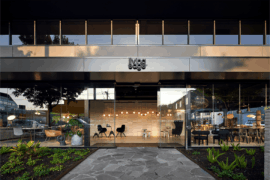The Architects Accreditation Council of Australia has released the new National Standard of Competency for Architects prioritising First Nations peoples and sustainability.

Consider the bar raised. The newly released 2021 National Standard of Competency for Architects (NSCA) has formalised two principles vital to the modern practice of architecture in Australia: respect for the environment and our First Nations peoples.
“Embedded within the practice of architecture is the recognition of Aboriginal and Torres Strait Islander Peoples’ ongoing connection and custodianship of Country, and the ethical responsibilities to the physical environment and the transition to a carbon-neutral built environment. These responsibilities are fundamental to architecture practice,” it states.
To be rolled out progressively in three stages over the coming 12 months, the updates come as the result of the Architects Accreditation Council of Australia’s (AACA) five-yearly review and have been developed through an 18-month-long process involving in-depth research and close engagement with stakeholders.
“We are proud that the 2021 NSCA enshrines a greater focus on more meaningful engagement with our First Nations peoples. As this year’s NAIDOC Week theme – Heal Country! – so clearly highlights, we have a long way to go in achieving real reform and reconciliation,” says Kathlyn Loseby, chief executive officer for AACA.
“We recognise that fundamental change is needed in the relationship Australia has with Aboriginal and Torres Strait Islander peoples,” she continues.
“We also acknowledge that we have so much to learn from the rich history and oldest continuing cultures on earth, not least when it comes to how we care for Country.
“With our climate in crisis and the built environment accounting for 36% of energy consumption, 38% of energy- related carbon emissions and 50% of resource consumption globally – and expected to double in total footprint by 2060i – urgent action is required.
“Architects are at the forefront of our capacity to transform the built environment’s impact on our climate into a carbon-neutral one. The NSCA is a critical tool in this change,” she says.
The staged rollout will start in January 2022 for the National Program of Assessment, July 2022 for the Experienced Practitioner and Overseas Qualification Assessment, and January 2023 for Accreditation and the Architectural Practice Exam.
A copy of the 2021 NSCA is available at aaca.org.au
Feature image: Newman Health Clinic by Kaunitz Yeung Architecture for Puntukurnu Aboriginal Medical Services (PAMS). Photo by Robert Frith Acorn Photography.
INDESIGN is on instagram
Follow @indesignlive
A searchable and comprehensive guide for specifying leading products and their suppliers
Keep up to date with the latest and greatest from our industry BFF's!

For Aidan Mawhinney, the secret ingredient to Living Edge’s success “comes down to people, product and place.” As the brand celebrates a significant 25-year milestone, it’s that commitment to authentic, sustainable design – and the people behind it all – that continues to anchor its legacy.

London-based design duo Raw Edges have joined forces with Established & Sons and Tongue & Groove to introduce Wall to Wall – a hand-stained, “living collection” that transforms parquet flooring into a canvas of colour, pattern, and possibility.

In this comment piece by Dr Matthias Irger – Head of Sustainability at COX Architecture – he argues for an approach to design that prioritises retrofitting, renovation and reuse.

MillerKnoll reimagines the convention of dinner table interactions by plating up a future-forward menu of sustainable design conversation starters as part of the inspiring “Conversations for a Better World” event series.
The internet never sleeps! Here's the stuff you might have missed

Poliform has mastered the art of seating that is both elegant and adaptable. These five designs highlight the balance between aesthetic impact and everyday ease.

Where style and substance truly dwell, Gardam’s latest modular collection – available through Stylecraft – balances elegance and versatility.

Whether you’re an architect, interior designer or student eager to learn, the 2025 Design Discussion series at Saturday Indesign will inspire fresh perspectives. Check out the schedule now!

Leeton Pointon Architects and Allison Pye Interiors have been awarded as the winner of The Living Space at the INDE.Awards 2025 for their exceptional project House on a Hill. A refined and resilient multigenerational home, it exemplifies the balance of architecture, interior design and landscape in creating spaces of sanctuary and connection.